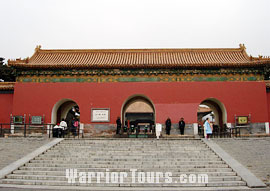Ming Tombs & Sacred Way

![]() Ming Tombs
Ming Tombs
Located at the foot of Tianshou Mountain in Changping District, about 50 kilometers (31 miles) northwest of the city area of Beijing, Ming Tombs is actually a range of imperial mausoleum constructions of thirteen emperors of the Ming Dynasty (1368 - 1644). Surrounded by lofty mountain ranges, the whole scenic area covers an area of 120 square kilometers (46 square miles) and is reputed to be the best preserved tomb architecture of its kind in China.
The thirteen mausoleums are arranged on a similar layout and vary in size. Of these, Changling, the mausoleum of the third Ming emperor Zhu Di, is the grandest with a splendid palace hall of Lingendian, similar to the Hall of Supreme Harmony in Forbidden City. It is said that just transporting the precious wood used to construct this tomb was five years' work for thousands of workers.
In addition, the magnificent underground palace of Dingling is another must for tourists. The underground palace has five great chambers which house the emperor's coffin and that of his two empresses. A collection of over 3,000 burial relics have been excavated. Among them, a pair of gold crowns embedded with precious pearls and gems are incredible. Tourists can appreciate the relic exhibitions in a museum nearby.
|
Admission Fee:
|
Changling Tomb: CNY 30 (Nov.1 to Mar. 31)
CNY 45 (Apr. 1 to Oct. 31) |
|
Dingling Tomb: CNY40 (Nov.1 to Mar. 31)
CNY 60 (Apr. 1 to Oct. 31) |
|
|
Opening Hours:
|
Changling Tomb: 08:30 to 17:30
|
|
Dingling Tomb: 08:30 to 18:00
|
|
|
Recommended
Time for a Visit: |
Two hours
|
|
Tourist Bus Route:
|
Bus No. 872 from Deshengmen.
|
| Bus Routes: | Bus No. 880 from Deshengmen to Ming Huang La Xiang Gong South Gate, and bus No. 314 to the Ming Tombs. |
![]() Sacred Way
Sacred Way
In ancient China, emperors considered themselves 'the Son of Heaven' and consequently they wished to prepare the way home after their deaths. The Sacred Way was a road usually built in front of an ancient Chinese mausoleum, which symbolically led emperors to Heaven. The Sacred Way in the Ming Tomb is a typical example.
The way starts with a grand and delicate archway carved out of marble. This is a popular entrance structure in most traditional Chinese architecture. Then the road is flanked with twelve pairs of lifelike stone statues of armor-clad generals, officers, lions, camels, horses, kylins and other legendary sacred animals. Following the stone statues at the end of the road is a grand Stele Pavilion. Inside the pavilion, there is a huge stone tortoise carrying a stone tablet called Shengong Shengde Stele, on which merits and virtues and achievements of emperors are narrated. These are laments expressing both the respect and deep grief of the bereaved. An elaborately carved marble ornamental pillar can be found on each cardinal point outside the pavilion. Behind the Stele Pavilion is a final construction called Dragon and Phoenix Gate.
|
Admission Fee |
CNY 20 (Nov. 1 to Mar. 31) |
|
CNY 30 (Apr. 1 to Oct. 31) |

